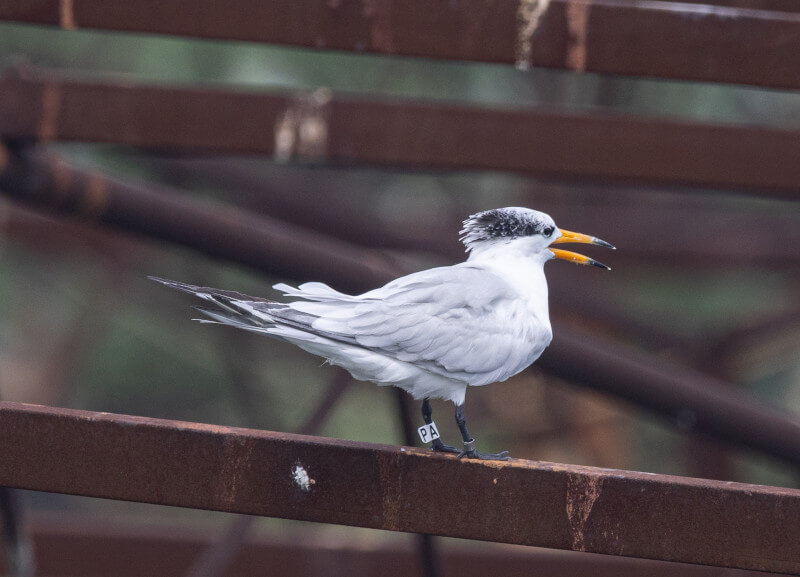
“PA” sighted at Jiaozhou Bay of Qingdao ©Xu Keyang
The connection between RoK-breeding Critically Endangered Chinese Crested Tern and Shandong Province in China was proven. On 6 August 2022, a Chinese Crested Tern with a white leg flag marked “PA” was seen at Jiaozhou Bay of Qingdao, Shandong Province, China. When checked with Korean researchers it was confirmed the bird was banded on 3 June 2022 in the Republic of Korea. Another RoK-banded bird, marked “PB”, was also seen at Jiaozhou Bay in August. These banded birds, and one more banded Chinese Crested Terns, were last seen at Gochang, southwestern Ro Korea, on 29 July.
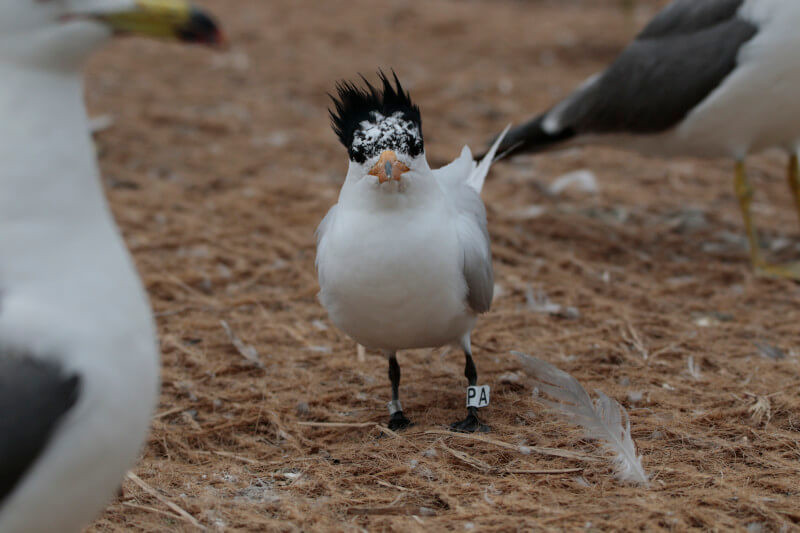
Chinese Crested Tern “PA” banded in RoKorea on 3 June 2022 ©Yunkyoung Lee
This is not the first time Korean banded Chinese Crested Tern was found in China. In 2021, a Chinese Crested Tern, banded in Korea with a small yellow band, was found at Rizhao, Shandong Province, China in late September. The banded bird was assumed to be banded at Matsu in 2011, when scores of crested tern chicks were banded with similar yellow bands. However, when the yellow-banded Chinese Crested Tern was seen again at Lanyang Estuary, Ilan, northeastern Taiwan on 21 June 2022, we felt skeptical on the assumption that the bird was banded in 2011, because the color band looked new and no Chinese Crested Tern with a small yellow band had been reported between 2011 and 2021. After carefully checking with Korean researchers we believe that was a banded first-year bird from 2021. This yellow-banded Chinese Crested Tern was also found at Jiaozhou Bay in August 2022.
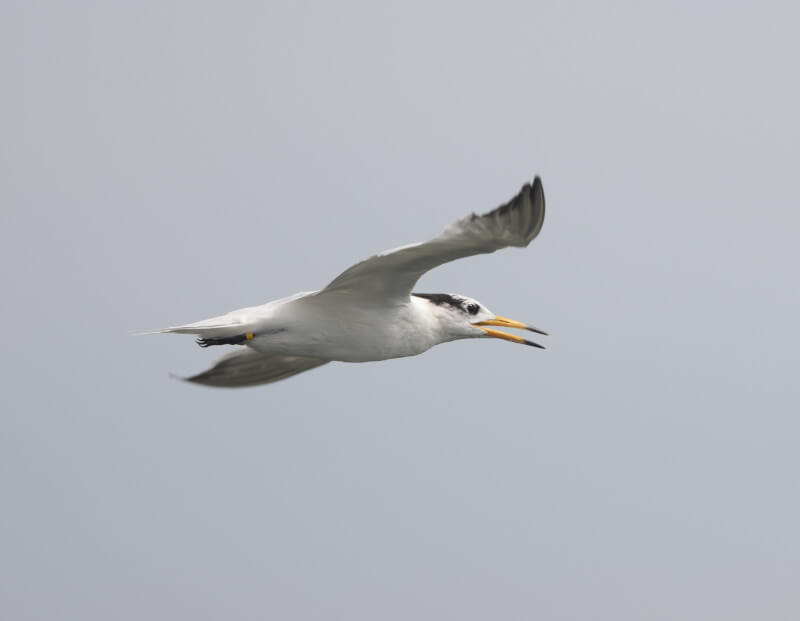
Chinese Crested Tern banded by Korean researchers in 2021 sighted at Jiaozhou Bay, China, on 14 August 2022 ©Xu Keyang
From old literature and specimen collection, we believed Chinese Crested Terns bred in Shandong in the vicinity of Qingdao, northeastern coast of China, as recently as 1937, and probably also bred in Korea near Incheon in the early 20th century. Breeding had not been recorded north of the Yangtze Estuary from 1937 to 2015 while a southern breeding population was discovered in 2000. However, since 2008 there were odd birds of Chinese Crested Terns observed north of the Yangtze Estuary (one seen at Chongming Dongtan, at the Yangtze Estuary on 5 September 2004). Since 2016, Chinese Crested Terns were regularly recorded in Shandong Province (Rizhao and Qingdao) every year and their numbers rapidly increased, reaching 72 birds recorded in Qingdao on 5 October 2021, and at least 82 birds were seen again in August 2022 (as on 23 August).
Based on the knowledge of breeding bird behavior, Simba Chan, who studied the breeding colony of the bird for two full seasons in 2014 and 2015, hypothesized that after fledging in the southern colonies (Jiushan, Wuzhishan, Matsu and Penghu), because of parental guidance of a traditional flyway, most Chinese Crested Terns would fly north and stay at the Yellow Sea area from August to October, before they start their southward migration. This was proven by a satellite-tracked Chinese Crested Tern chick tagged in Matsu in 2017 as part of a research project by National Taiwan University (but signal was lost when it reached Jiaozhou Bay of Qingdao on 24 September 2017). It is unlikely another breeding colony of Chinese Crested Tern exists in the Yellow Sea (apart from the Korean site) at present but breeding colonies can be restored from an understanding of breeding biology at the Korean breeding site of Chilsando.
The rapidly increased number of Chinese Crested Terns reported from Shandong after breeding season is likely to be the result of successful restoration and protection of breeding sites in the south, particularly Jiushan Islands in Zhejiang Province in China. Since 2014, at least a dozen Chinese Crested Tern chicks fledged from southern colonies every year. And the number of fledged chicks increased to 30 to 40 annually in recent years (in Jiushan alone, at least a total of 151 Chinese Crested Tern chicks fledged between 2013 to 2022). Chinese Crested Terns banded in Jiushan and Matsu have been recorded in Shandong, but not until 2021 the connection between Korean-breeding birds and Shandong was proven. This gives hope for the restoration of more northern breeding sites of the Chinese Crested Tern both in Shandong and Ro Korea in the near future.
To understand migration routes of the Chinese Crested Tern (and its close relative Great Crested Tern), satellite tracking has been applied at some sites but this must be done with extreme care as there is evidence from migration studies that tagging of birds should be prevented before they start their long-distance migration. Color-banding has proven to be a much safer way to study their migration and more individual data can be collected, but the color code should be well coordinated within the flyway.
At this stage, the following basic color codes were used for Chinese Crested Tern and Great Crested Tern at different locations (some crested terns were fitted with different colors before the banders could obtain the right color bands):
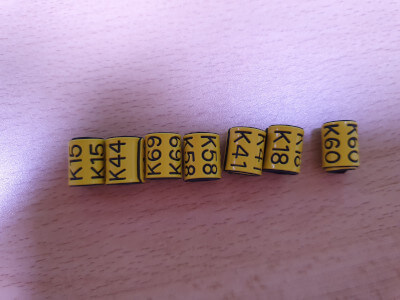 Yellow bands used in RoKorea ©Yunkyoung Lee |
Republic of Korea: Yellow band engraved with three digits (Letter K and two numbers) |
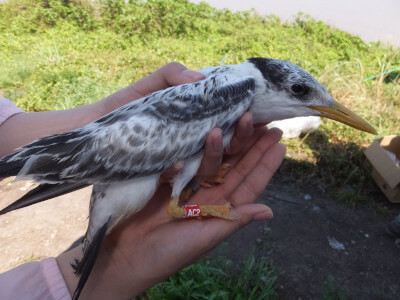 Greater Crested Tern chick banded in Zhejiang ©Simba Chan |
Zhejiang: Red band engraved with three digits |
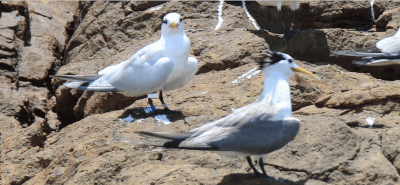 ©Allen Lyu/WBST |
Matsu and Penghu: Blue flag engraved with three digits, with another white flag on the top |
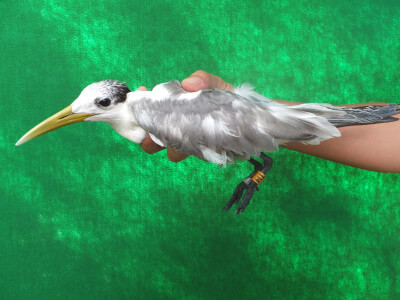 Greater Crested Tern banded in Indonesia ©Simba Chan |
Indonesia: Orange band engraved with three digits |
If you find crested terns with color bands please report to Mr. Yat-tung Yu, Coordinator of EAAFP Seabird Working Group (bfspoonbill@hkbws.org.hk) and the banding scheme/center of your country.
Article prepared by Simba Chan from Seabird Working Group.




